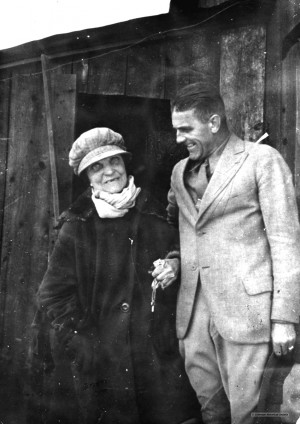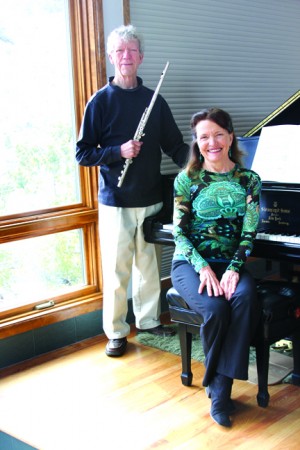by Ed Quillen
Martha tells me that people have come up to her at work and whispered something like “I saw Ed at the hospital. Is he okay?”
I don’t know why they don’t just ask me that, because when I lost some weight a few years ago, I got many inquiries along the lines of “Are you all right?” In general, I was, and I told them so, but perhaps my protestations back then made people reluctant to ask me directly now.
I have gone to Salida’s fine new hospital (formally it’s a “regional medical center”) at least once a month since the start of this year. I’m strictly an out-patient getting a blood test from the lab, and I’ve never spent more than a few minutes in the building. I’m in and out so quickly that I’m rather surprised that anybody notices.
Why the blood tests?
Toward the end of last year, I had trouble focusing my eyes. The world was getting blurry.
No big problem, I figured. This just means it’s time for an eye exam and new glasses. Several years had passed since I’d done that. My eyes have never been that sharp. I’m seriously near-sighted. I’ve worn glasses since I was eight years old, and bifocals since I was 10.
So I made an appointment with my eye doctor, Larry Lund here in Salida. I’ve been going to him for years. I enjoy the appointments; Larry’s a Republican and we can argue some politics and swap a few jokes while he runs me through the tests.
This time around, he had some good news and some other news. The good news was that my eyesight was getting sharper (it astonished me that any part of your body gets better after age 50, but he insisted that was the case) and so the next set of bifocals wouldn’t have to be as strong.
Then came the other news. “But I can’t prescribe new glasses until you get this diabetes under control.”
“This what?” I exclaimed. It was total news to me, although I shouldn’t have been shocked. The tendency to Type 2 diabetes is hereditary, and both my parents have it. I suspect my two brothers do, too, based on how carefully they order when we eat out together, though it’s not something we’ve discussed.
Learning that you have a chronic ailment is depressing, but it hits even harder when you’re one of the 46 million Americans who doesn’t have health insurance. I can’t afford it. Not when I also need to pay my eye doctor and my dentist, and mechanics and plumbers, and keep a roof over my head.
Besides, my basic theory is that the best way to stay functional is to avoid doctors.
After all, they get paid to find something wrong with you. Now, if you wave some money at me and want me to examine your writing with the prospect of more paying work if I find can something wrong, I can find split infinitives or misplaced modifiers. And I could do it in good conscience, since that’s what you’re paying me to do.
And in my experience, doctor visits usually involve the obvious, like being told that it would be good to lose a few pounds, or to stay in bed and drink plenty of liquids if I’ve succumbed to the crud that comes around every now and again.
So, no, I didn’t have regular check-ups that might have caught this earlier. I do go to the annual KUSA Health Fair every now and then, but it’s been a couple of years. I couldn’t remember exactly when I’d last been to a regular doctor; sometime in the late 1980s when I took a tumble off a bicycle.
What to do about the diabetes? Dr. Lund doesn’t treat diabetes. He can diagnose it because excess glucose damages the retinas in one’s eyes, and that can cause blindness if allowed to persist.
There are two ways one must act. One is to get the eye damage repaired through laser surgery, and the second is to take up diet and exercise and blood-sugar monitoring so that you don’t cause further damage.
The surgery required a couple of trips to a clinic in Colorado Springs. You can’t drive for about eight hours after a clinic visit, as your pupils are so dilated that a new moon at midnight would seem blinding. On my January trip, I drove down, got a room, took a cab to and from the appointment, stayed the night and returned the next day. It wasn’t nearly as exciting as a trip to the city should be.
The second trip, in early April, Forrest Whitman offered to drive me to and fro. I told him how to find the tiny bohemian zone in the Springs (Acacia Park area with bookstores and coffee houses), so he could enjoy the wait during my appointment, and on the way back I bought him dinner at one our favorite establishments, the Owl Cigar Store & Pool Hall in Cañon City.
After the surgery, my vision is perceptibly sharper, so I’ll soon get new glasses. I should be able to read with them on, instead of having to take them off and hold a magazine a few inches from my nose.
As for the rest of my diabetes treatment, I didn’t really have a doctor to call, but I remembered reading about the Chaffee People’s Clinic in this very magazine. I called. It was set up for Chaffee County residents of limited means who have chronic conditions and no health insurance. I was a custom fit for that, and its suggested fees were quite affordable.
I was pleasantly surprised on my first visit. I had anticipated having to wait for hours in a room teeming with distraught mothers and screaming toddlers, for previous medical visits to private offices generally meant a long wait – i.e., a 2:30 p.m. appointment meant you’d get served around 3:45 p.m. Sitting for a long time in a room full of sick people never struck me as a route to health.
But at the Chaffee People’s Clinic, a 4 p.m. appointment means seeing somebody at 4 p.m. Hooray for socialized medicine, or public health care, or whatever you want to call it, and thanks to all those donors and volunteers who make it work here.
I learned how to check my glucose level and to adjust my diet, eating more fruits and vegetables which Martha has been glad to feed me. I can eat peanut butter, as long as I get the “all-natural” kind that has only peanuts; most brands add a sweetener for reasons I can’t fathom.
One pleasing discovery is that salsa counts as a vegetable, although the only sugar-free brand I’ve found is Pace. All the others have sugar, or high-fructose corn syrup, or maltose or dextrose – basically, if there’s anything on the label that ends in “ose,” I shouldn’t touch it. And it’s astonishing how much sweetener you find in food, even when you’re avoiding cake and candy.
Then there’s exercise. I’m supposed to get 30 to 45 minutes a day. Our dog Bodie is a world-class nag about his daily mile-or-so walk, so I’m covered there. I take some prescribed pills, but I don’t need to inject insulin.
Type 2 diabetes (the adult-onset kind) is often associated with obesity. I’ve been obese; a decade ago, I weighed about 220 pounds.
But then I shed weight. The main reason is that my teeth were going bad. Eating often hurt, and though pain is not a weight-loss method that anyone recommends, it sure cuts the pounds. I dropped to about 165. People noticed and I had to keep assuring them that I wasn’t wasting away with some dreadful terminal affliction.
So in my diabetes dieting, I don’t really have to worry about calories, since my weight is in range. Even so, I’ve had to cut down on carbohydrates, and I miss my potatoes and pasta. I have been advised that I can have one glazed doughnut per year, and I’m saving that for my birthday.
My glucose is down and my blood tests are looking pretty good. But the annoying part about diabetes is that it’s chronic. It isn’t like the flu, where you feel like retching fevered hell for a couple of days, then recover and go about your life. I’ll have to take better care of myself and watch my diet for the rest of my days.
So now you know why you might see me sitting in the lobby at the hospital every now and then.
Ed Quillen is grateful for the Chaffee People’s Clinic, but still glad that the health-care reform bill passed.


